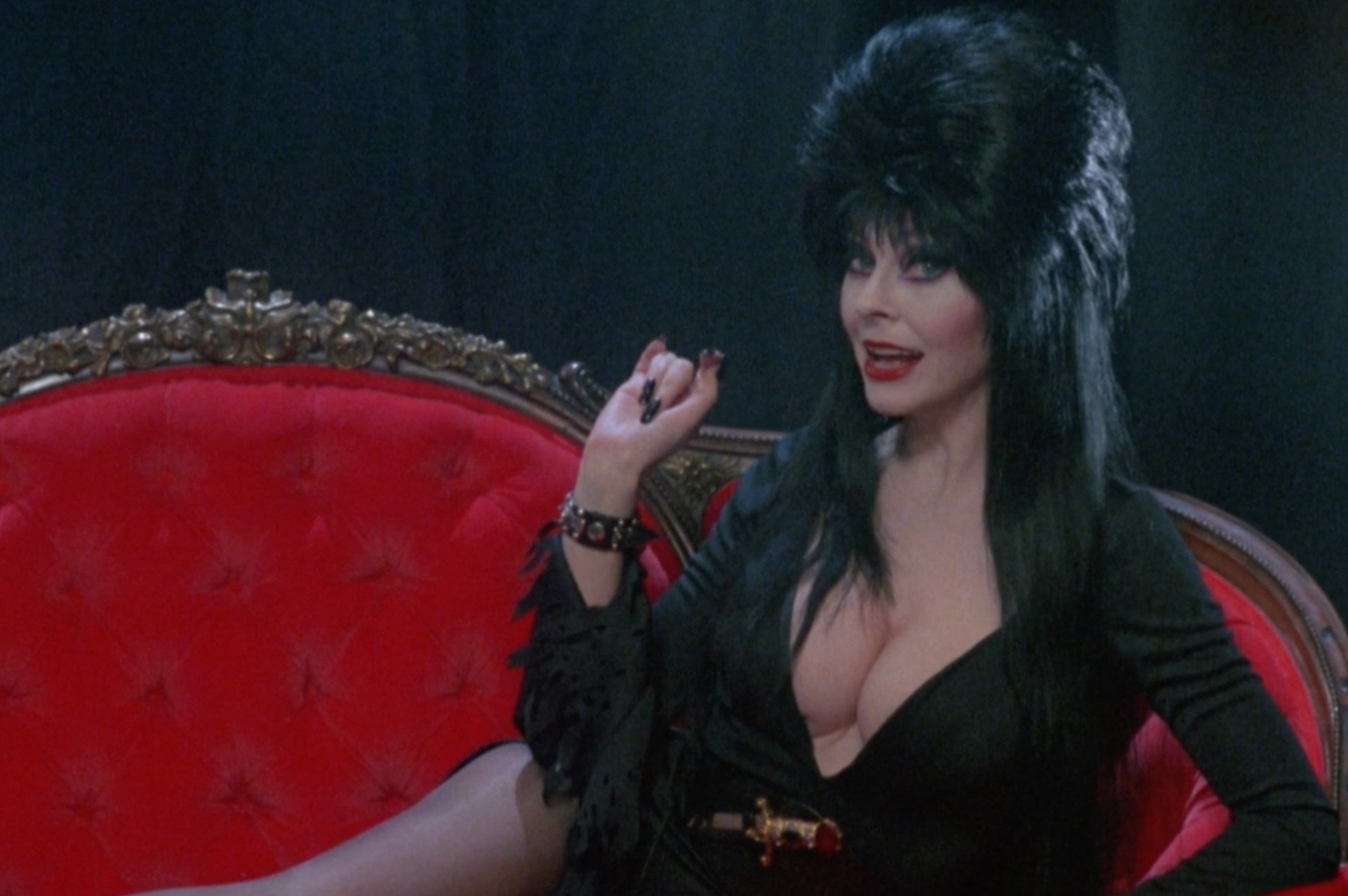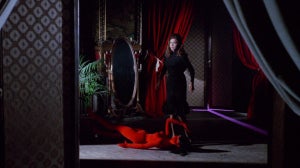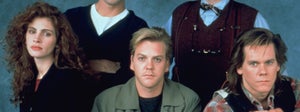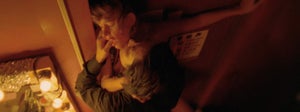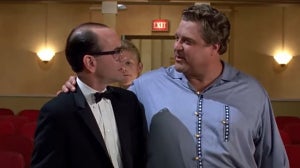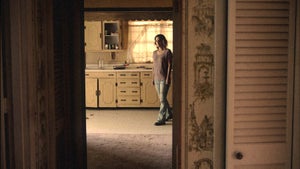
“That girl thinks she's the queen of the neighborhood
I got news for you, she is!”
“Rebel Girl” Bikini Kill
Merriment and the macabre. These are two often strange bedfellows that when given the right balance of potions, motions, and notions, can make some very sweet music together. In film, while it can be dated back to the days of Abbot and Costello Meet Frankenstein (1948) and James Whale's pre-code stunner, The Old Dark House (1932), the age of comedy and horror being combined was arguably its most prolific during the 1980s. From stone-cold classics like Return of the Living Dead (1985) and Re-Animator (1985) to rough-around-the-edges gems (IE. Transylvania 6-5000 (1985) and 1987's Blood Diner) to the center of bad ideas (IE. 1988's Saturday the 14th Strikes Back), horror and comedy were seeing a LOT of each other in this time period.
So, what better time in popular cinema for a wildly successful horror host to crossover from introducing assorted campy cult films to starring in their very own campy cult feature than the 1980s?
Forgive this interruption for a brief PSA, but due to past frissons in my writing history, I must note that words like “campy” are always used with the utmost love from my motley little heart. If it offends you, then know that is not the intent, and whatever you do, don’t browse social media or pay attention to the news, because your delicate sensibilities will be nuclear annihilated into particles upon articles, my little lambling.
Anyways, without further ado, welcome to 1988’s Elvira: Mistress of the Dark!
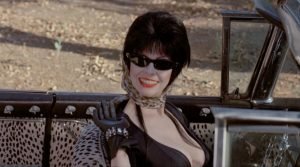
Directed by James Signorelli, Elvira: Mistress of the Dark is on the surface a zany fish-out-of-water-comedy where our titular vamp of camp ends up in a sleepy, Norman Rockwell-esque small American town and horrifies the locals while delighting the audience with her fierce wit and papa-oom-mow-mow pulchritude.
All of this, while technically true, belies the fact that this film is one not only subversive but is rightfully salty while never losing any wit one-two-three slobberknocker to the moral majority’s insidious toxicity that was fever pitch throughout the decade. The script, written by Elvira’s creator, physical embodiment, and alter ego, Cassandra Peterson, her fellow former Groundling and frequent collaborator, the late and extremely underrated John Paragon, and Sam Egan is as cute as it is savvy with the savage.
Elvira as a character, whether it’s as a horror hostess with her Movie Macabre show, iconic TV commercial appearances with Coors Light and later on, Mug Root Beer, or in this film, is the perfect blend of cheek and blazing self-agency. She never takes herself too seriously but pulls the brakes before it can ever veer near gross parody or dumb-sexy girl schtick. After all, just because she may occasionally talk like a valley girl, Elvira is nobody’s dummy.
The core plot begins when after quitting her latest local TV horror hosting gig after refusing to put out to the station owner, Elvira receives the news that her great aunt Morgana has named her in the will. She packs up her things and road treks it out to the small burg of Falwell, Massachusetts for the reading. When she arrives, many of the locals have an instantly negative reaction to this raven-haired, glammed-up beauty in a skin-tight dress with a feisty spirit and razorwire comeback. The local unwelcoming parade is spearheaded by Chastity Pariah, played by the always brilliant Edie McClurg.
First of all, THAT character name! It’s on-the-nose but like so much of the film, it works so well. Subtle was not a character name not to mention the town being a clear reference to the late pastor/hate-monger Jerry Falwell, the humor is not overtly subtle, but given the subject matter at hand, it is more than fitting. (After all, extreme conservatism, especially during the 1980s, was not big on delicacy except for the already converted and willfully blind.) McClurg, who came up in that same magical era of the Groundlings that also begat not only the aforementioned Peterson and Paragon, but also Phil Hartman, Paul Reubens, and Lynne Marie Stewart (The latter has a small cameo here as the bartender in Falwell’s humble bowling alley.), is one of those actors who is consistently an ace in the deck.
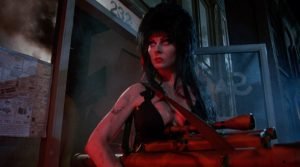
Looking back on this film, which is now over 35 years old, Chastity as a character is the second-worst kind of proto-Karen that plagues the vistas and valleys of the United States. (She’s only the second worst due to not being an obvert weapons enthusiast.) Entitlement by itself is one of humanity’s uglier traits, but when combined with judgment, creates some of the most toxically obnoxious people. From her immediate and continual slut-shaming comments about and towards Elvira to, in a different scene using the word “swarthy” in a derogatory fashion, all makes Chastity Pariah is one formidable villain in a hideous poly knit blend outfit with barely hidden racist, anti-sex, and just anti-fun attitudes to match. McClurg nails all of this and more of her usual zest, pinpoint wit, and general aplomb. Even though technically the more classically evil in a traditional horror sense is Vincent Talbot (William Morgan Sheppard), a down-low warlock and Elvira’s blood-uncle who is vying to possess a powerful grimoire that had belonged to Morgana, the true fear is Chastity and her small but mighty legion of repressed harpies and hypocrites.
All of this comes back to our woman of the hour who is always too sweet to be sour, our titular Mistress of the Dark herself, Elvira. One of my earliest female role models as a little kid was this woman, who was and is, rock and roll authority with a Vegas showgirl’s body and a blazing brain to match! We live in a world that constantly prizes not making waves and blending in the status quo crowd from cradle to grave, which is why Elvira and the lineage of horror hosts and hostesses are so important. From the original Cool Ghoul himself, John Zacherle to the wasp-waisted and wondrously weird Vampira to Ghoulardi and his official heir, my personal saint, The Ghoul, and many more, horror hosts, especially from the 1950s to the 1980s, tapped into potent cultural wells for so many kids, teens, and adults alike. Vampira was like if Charles Addams read Baudelaire and listened to George Antheil, whereas Ghoulardi and especially The Ghoul, were proto-punk with their irreverent spirit. (Plus, the latter was playing songs like “The Crusher” by the Novas on his show long before it was covered by The Cramps.) It’s that phantasmagoric pool that gives us vital art like Mad Magazine, Miles Davis, The Stooges, Wacky Packages, Coven, The Residents, The Plasmatics, heck, speaking of The Cramps, let’s throw them in there too, all the while tapping into one of the least respectable film and literature genres ever---horror.
Elvira as a character is begotten from this with Peterson integrating not only her own comedic verve and natural charisma, as well as her rich and diverse entertainment background for extra measure. She was the youngest working showgirl in Vegas as a teenager, fronted a rock band, modeled in men’s magazines, and hung out in drag clubs. If anyone is born to be an icon, it is Cassandra Peterson.
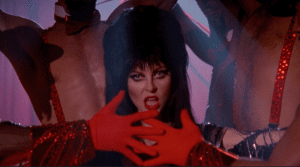
Elvira, especially throughout Mistress of the Dark, operates like a one-woman lighting rod that reveals one’s true nature. When a character is a shallow person who instantly assumes that a single woman in a sexy dress is dumb at best and a peen-gobbling homewrecker from Hades at worst, Elvira’s mere presence backed with a well-timed sassy quip immediately rips away all false polite faces. In fact, the biggest boobs seen in Elvira: Mistress of the Dark are not on her but all around her.
The cornucopia of terrible people ran the gamut from horny station owners that think sexual harassment is a right to handsy mooks to “moral” townsfolk that literally try to burn her at the stake. The best part is that all get bested by our girl. Even early on, when she picks up a creepy hitchhiker, we see him in the next scene run out of her car, the incredible black beauty of a customized 1959 Ford Thunderbird known as the Mobile Macabre, looking terrified and disheveled. With one of the best gags in the whole film, Elvira gets the last word by yelling, “Hey, you forgot something!” as she throws an ax at him!
Elvira: Mistress of the Dark is one thrill ride of cult cinema, giving us the gifts of sharp writing, great actors, punk-rock dog makeovers, cleavage that can break through chains, high heels as weapons, casseroles gone so wrong that they swerve to the right, and a heroine who fights for her dreams on nobody’s else's terms but her own. Even the song that plays throughout the opening credits, “Once Bitten, Twice Shy,” (not to be confused with the 1975 Ian Hunter song that was later on covered by Great White) sung by glamazon Lori Chacko is a high-octane treat. Chacko herself has further street cred than this since she plays one of the patients in Stephen Sayadian’s delirious and eternally delightful 1989 film, Dr. Caligari.
At the end of the day, Elvira: Mistress of the Dark, is a movie that is rightfully lambasts the moral majority as the barf-inducing buffoons they truly are and gives the audience the best kind of moral message of staying true to yourself and never let the less worthy steal your power, glow, or glistening cleavage. (Okay the last one is more of a your mileage may vary kind of affair, but still, don’t knock its reverbs, baby!) There are few films, especially in the comedy/horror hybrid subgenre, whose power is so firmly rooted in the inspirational, but with a dynamo of an artist like Cassandra Peterson involved, Elvira: Mistress of the Dark is the movie that was needed in 1988 as it is right now.
https://www.youtube.com/watch?v=AZdrAqH78l8

